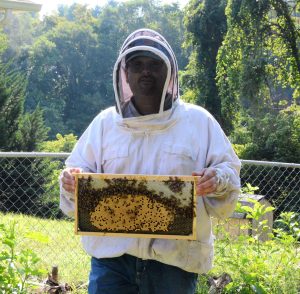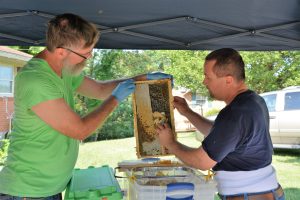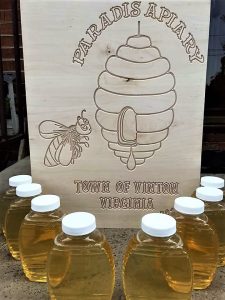By Debbie Adams
Beekeepers look forward to the day they are able to reap the benefits of their bees’ months of hard work–and their own–by harvesting the honey produced.
Paradis Apiary in Vinton had a super busy day on July 25, harvesting 106 pounds of honey and 18 honeycombs.
Mark Paradis, his wife Lenore, daughters McKenna and Alivia, his in-laws, and fellow beekeepers, Hugh and Dawn Hughes, were up early preparing for the sticky harvest.
They set up tents for the honey extraction process to start with, before the men suited up, armed with a bee smoker, and began removing the frames from the hives.
Once the assembly line was set up for the honey extraction, Paradis and Hughes carefully examined and removed the frames of capped honey from the hives, one at a time. (Capped honey is the thin layer of new wax that bees build over the top of cured honey.) They placed the frames in a plastic tub and then in a wheelbarrow which they rolled up to the tents in front of the house.

They then removed one frame at a time, held it vertically and used a honey rake to scrape the wax cappings from the frame into a strainer placed over another plastic container.

Once that step was complete, the scraped uncapped frame was placed inside the stainless-steel honey extractor Paradis had rented from the beekeeping association. The scraped beeswax left behind was set aside for making candles and other products.
A five-gallon bucket, topped with a strainer, was placed below the spout of the extractor to collect the honey that was spun out of the frames over several minutes. Three frames are placed in the extractor at a time.

Once the honey was spun out and filtered, it was ready for bottling. The empty honeycomb frames were ready to return to the hives.

Some honeycombs were cut from the frames for packaging as Cut Comb squares as well.
(Beekeepers don’t remove all the honey from the bees. Harvesting is done when the bees have surplus.)
Paradis Apiary got its start in 2019 when McKenna became a bee enthusiast as one of the original members of the William Byrd Middle School Beekeepers Club. The entire family developed an interest in bees and beekeeping to the point that they built hives (now numbering seven) in their backyard. Mark is now serving as president of the Blue Ridge Beekeeping Association.
Turns out bees are one of the most fascinating creatures on earth. Honeybees–called the hardest working species of bees–collect flower nectar and convert it to honey which is stored in their hives. Bees will fly as far as five miles to find flowers from which they obtain the pollen—the necessary ingredient in making honey.
The nectar is transported in the stomach of the bees and is converted to honey through the addition of digestive enzymes, and by being stored in a ‘honey cell’ and then partially dehydrated.
Nectar and honey provide the energy for the bees’ flight muscles and for heating the hive during the winter period. Honeybees also collect pollen which supplies protein and fat for the bee brood (the egg, larvae, and pupae stages) to grow. Not all types of bees can create honey.
“We’re all in this together” has special meaning for honeybees as it takes an entire hive to make the honey. Every bee has a special role.
The first step is with the worker bees who live only about four weeks in the spring and summer (winter bees live about three months). They have long tongues which serve as straws to suck the nectar out of flowers and store it in their second stomach. (Honeybees are covered with tiny hair follicles that the pollen sticks to.) But the worker bees aren’t finished quite yet.
On their flight back to the hive, their honey stomach starts creating a mixture of enzymes and nectar, removing water from the nectar.
Once the worker bee gets back to the hive, the house bee takes over. It sucks the nectar out of the worker bee’s stomach, chews the nectar for about 30 minutes to add enzymes, and ends up with a syrupy like liquid.
The syrup is then distributed all over the comb of the hive as the bee spits up the nectar that was just chewed and leaves it inside the honeycomb. When the syrup finally has enough water evaporated from it, it is capped by beeswax—the final step in the process of honey and beeswax production.
Honeybees are the only insects on earth that can do this vital job. That’s why beekeepers like the Paradis family and the Blue Ridge Beekeeping Association are so invested in protecting honeybees to make sure they never become extinct. Bees are critically important to society and the economy–they pollinate 100 North American crops.
Honeybees generally make their honey during the warmer months, when there are plenty of flowers around to obtain nectar and pollen from. They must rely on their summertime supply to help the hive endure through the winter. Paradis thinks that is most likely why he has such a bumper crop of honey this year—the extreme heat in the area this July.
It takes around 1,150 bees to make a 16-ounce jar of honey. One colony can produce anywhere from 60 to 100 pounds of honey per year. An estimated 2 million flowers are touched in the process of producing that one pound of honey.
The Paradis Apiary honey is a distinctive light color and delicious to taste. They believe because of its color that it comes mainly from the locust trees in the area.
Their bees have always been local bees. Paradis started out with about 10,000 bees, which came from a friend. That number has increased tenfold. He has rescued several swarms of bees locally and placed them in hives as well.
The Paradis family has lived in Vinton for 20 years and owns about 1.7 acres of partially wooded land. They have added flowers and other plants that are attractive to bees to their landscaping.
Paradis has a Facebook page filled with information and videos on honeybees and their journey as new beekeepers at “Paradis Apiary in the Town of Vinton, Virginia.”
Paradis Apiary honey is now on sale in 16-ounce plastic squeeze bottles and in Cut Comb squares. Visit their Facebook page or https://paradis-apiary.square.site/ to order.












